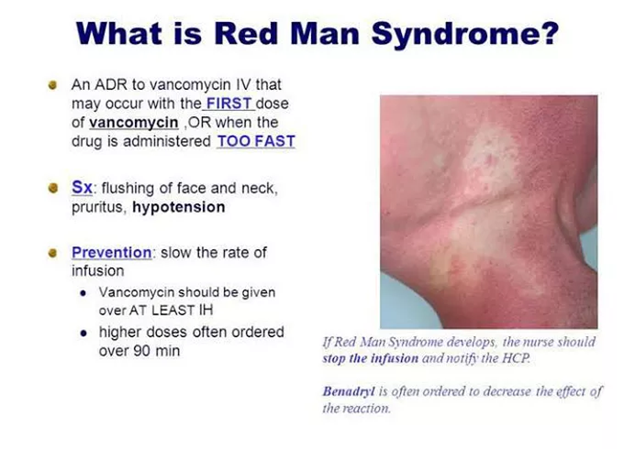The nurse is caring for a patient who is receiving vancomycin (Vancocin). The nurse notes that the patient is experiencing flushing, rash, pruritus, and urticaria. The patient's heart rate is 120 beats per minute, and the blood pressure is 92/57 mm Hg. The nurse understands that these findings are consistent with:
allergic reaction.
rhabdomyolysis.
Stevens-Johnson syndrome.
red man syndrome.
The Correct Answer is D
Allergic reaction: An allergic reaction can manifest in various ways, including rash, itching, and difficulty breathing. However, the specific symptoms described, along with the context of vancomycin administration, point to red man syndrome in this case.
Rhabdomyolysis: Rhabdomyolysis is a condition where damaged muscle tissue breaks down and releases a protein called myoglobin into the bloodstream. This can cause kidney damage, but the symptoms described do not align with rhabdomyolysis.
Stevens-Johnson syndrome: Stevens-Johnson syndrome is a severe skin reaction that can cause skin and mucous membranes to blister, peel, and can be life-threatening. While it can present with rash and other skin symptoms, the symptoms mentioned in the scenario are more characteristic of red man syndrome.
Red man syndrome: As mentioned earlier, red man syndrome is an allergic reaction to vancomycin characterized by flushing, rash, pruritus, and urticaria (hives), along with rapid heart rate and low blood pressure. It is specific to vancomycin and can be prevented or minimized by slowing down the infusion rate and administering antihistamines.

Nursing Test Bank
Naxlex Comprehensive Predictor Exams
Related Questions
Correct Answer is D
Explanation
A. Obtaining all cultures before the antibiotic is administered: While obtaining cultures is important for identifying the specific pathogen causing the infection and guiding targeted antibiotic therapy, waiting for culture results can take time. During this time, the infection can progress. Therefore, it's generally recommended to initiate broad-spectrum antibiotics first and then adjust the treatment based on culture results.
B. Delaying administration of the antibiotic until the culture results are available: Delaying antibiotics until culture results are available can be risky, as it allows the infection to progress, potentially leading to sepsis or other severe complications.
C. Administering antipyretics as soon as possible: Administering antipyretics like acetaminophen or ibuprofen can help reduce fever and make the patient more comfortable. However, the primary intervention for a suspected infection is antibiotic therapy, as it targets the underlying cause of the fever.
D. Administering the antibiotic immediately: When dealing with a patient with a fever of unknown origin and a suspected infection, the priority is to start appropriate antibiotic therapy promptly. Delaying antibiotic administration can allow the infection to worsen, leading to serious complications.
Correct Answer is C
Explanation
A. 8:00 AM: This time is too early to draw a trough level for a medication administered at 10:00 AM. The trough level should be drawn just before the next dose is given to get the lowest concentration in the bloodstream.
B. 11:00 AM: This time is after the scheduled dose of vancomycin at 10:00 AM. Waiting until 11:00 AM would not provide an accurate trough level because the patient has already received the medication.
C. 9:00 AM: This is the correct time to obtain the patient's blood sample. It is one hour before the scheduled dose of vancomycin at 10:00 AM. Drawing the trough level at this time ensures it reflects the lowest concentration of the drug in the bloodstream.
D. 12:00 noon: This time is after the scheduled dose of vancomycin at 10:00 AM. Waiting until noon would not provide an accurate trough level because the patient has already received the medication.
Whether you are a student looking to ace your exams or a practicing nurse seeking to enhance your expertise , our nursing education contents will empower you with the confidence and competence to make a difference in the lives of patients and become a respected leader in the healthcare field.
Visit Naxlex, invest in your future and unlock endless possibilities with our unparalleled nursing education contents today
Report Wrong Answer on the Current Question
Do you disagree with the answer? If yes, what is your expected answer? Explain.
Kindly be descriptive with the issue you are facing.
